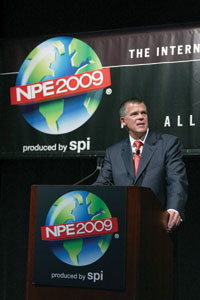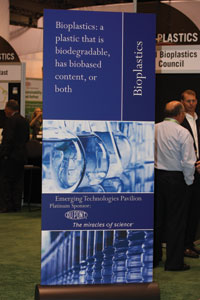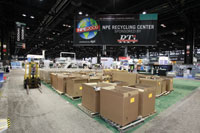 As President and CEO of SPI: The Plastics Industry Trade Association, I know all too well how hard the current economy has hit this country’s manufacturers. And yet, this summer SPI attracted more than 40,000 professionals from nearly 19,000 companies and 101 countries to Chicago. The event: NPE2009, our industry’s triennial trade show.
As President and CEO of SPI: The Plastics Industry Trade Association, I know all too well how hard the current economy has hit this country’s manufacturers. And yet, this summer SPI attracted more than 40,000 professionals from nearly 19,000 companies and 101 countries to Chicago. The event: NPE2009, our industry’s triennial trade show.
The key reason we were able to hold a successful manufacturing trade show during these challenging times: the incredible interest in sustainability.
Environmental Sustainability
Energy efficiency, resource conservation and waste reduction are not only high priorities in Congress and in the Obama Administration, but they are top-of-mind for consumers as well. At our trade show, that meant companies were eager to showcase innovative products and technologies that demonstrate how plastics provide solutions to environmental sustainability issues. Resource conservation, renewable resource utilization, recycling, solid waste source reduction, energy efficiency, elimination of pollutants, shrinking carbon footprints – virtually every visitor at our show had a vital interest in one or more of these goals. Our industry has embraced the consensus that sustainability is the pathway to the creation of new customer values, and the construction of a viable 21st century business model.
Plastics save energy. It often takes less energy to convert plastics from a raw material into a finished product than comparable products made of other materials. Foam polystyrene containers take 30 percent less total energy to make than paperboard containers. Fifty-three billion kilowatt hours of electricity are saved annually by plastics-related improvements in major appliances; without the benefits provided by plastics insulation, these appliances would use up to 30 percent more energy.
Indeed, fuel savings is the advantage cited most often by our customers who are seeking new materials and processing methods that yield lightweight and more compact products. Plastics reduce fuel consumption, both directly and indirectly. For example, over the lifetime of the average car, plastic automobile components save 650 gallons of gas as a result of their lighter weight. Plastics have also consistently reduced the weight of truck payloads and allowed companies to ship more products in fewer trucks – saving energy. For instance, 2.8 million plastic grocery bags can be delivered in one truck; the same truck can hold only 500,000 paper grocery bags.
Growth of Bioplastics Our industry has also seen a surge in the growth of bioplastics – materials that are biodegradable and derived from corn, soybeans, potatoes and other renewable resources – which illustrates the innovation that can help reduce our nation’s dependence on oil and natural gas. Currently used in a variety of applications (including packaging, fibers for apparel, and home and garden), the bioplastics business is estimated to grow at an almost 18 percent annual rate. They cover a broad range in terms of what they can do. And like conventional plastics, properties can be tuned to meet the needs of the application by blending or using certain additives and modifiers.
Our industry has also seen a surge in the growth of bioplastics – materials that are biodegradable and derived from corn, soybeans, potatoes and other renewable resources – which illustrates the innovation that can help reduce our nation’s dependence on oil and natural gas. Currently used in a variety of applications (including packaging, fibers for apparel, and home and garden), the bioplastics business is estimated to grow at an almost 18 percent annual rate. They cover a broad range in terms of what they can do. And like conventional plastics, properties can be tuned to meet the needs of the application by blending or using certain additives and modifiers.
In part due to the considerable increase in retailer and consumer demand for bioplastics, in 2008 SPI launched the Bioplastics Council. This Council provides a forum to promote the development of bioplastics as an integral part of the plastics industry, as well as to educate the industry, the government and the value chain as to what bioplastics are, what types of applications this type of plastic can be used in, and the growth opportunity for the bioplastics market.
Currently comprised of seven member companies, the Bioplastics Council recently published the first-ever Bioplastics Industry Overview Guide. Filling the void for a comprehensive encapsulation of this relatively new but fast-growing market of the plastics industry, the new 26-page Guide provides readers with information concerning trends and challenges; similarities and differences amongst different bioplastics; applications and uses; companies in the industry; production estimates and projected market growth.
Additional Council activities planned for 2009 are the development of guidance material to address issues such as “food versus fuel” as well as a bioplastics-related life-cycle assessment (LCA) project.
Plastics Used in Energy Projects
In addition, alternate energy sources increasingly require plastics as essential materials of design, and our members are on the leading edge in development of solar energy, lithium-ion batteries for electric-drive cars, and wind energy systems. When it comes to solar power, traditional silicon-based solar cells are expensive and difficult to handle. Plastic (polymer) solar cells are more cost-effective. Plastics are used for wind turbine covers, and fiber-reinforced plastics are the material of choice for large, commercial scale wind energy rotor blades.
On August 3, when the U.S. Department of Energy selected 28 new wind energy projects for up to $13.8 million in funding, Energy Secretary Steven Chu said, “Wind energy will be a critical factor in achieving the President's goals for clean energy, while supporting new jobs."
Plastics Used in Construction
In the world of building and construction, plastics provide an outstanding range of properties (such as durability, lightweight and good barrier properties) which are critical to green building design – design of structures that efficiently use energy, water and other resources; protect occupant health; and reduce waste, pollution and environmental degradation. In addition, plastics play a critical role in newer technologies being used in green buildings such as wind power, solar cells and cool roofing (highly reflective and emissive materials that stay cooler in the summer sun, thereby reducing energy costs.)
“Walking the Walk" Of course, our industry must also “walk the walk” in terms of our own operations. For the past 20 years, SPI has urged the industry supply chain to implement best management practices, such as Operation Clean Sweep ®, to prevent resin pellets from reaching our natural environments. Loose plastic pellets present an occupational hazard inside manufacturing plants as they make their way into public waters where they don’t belong. With a goal of “Zero Pellet Loss,” 140 companies have committed to the program and are carrying out SPI’s recommendations for pellet containment practices. There is more to do, but SPI member companies continue to lead by example.
Of course, our industry must also “walk the walk” in terms of our own operations. For the past 20 years, SPI has urged the industry supply chain to implement best management practices, such as Operation Clean Sweep ®, to prevent resin pellets from reaching our natural environments. Loose plastic pellets present an occupational hazard inside manufacturing plants as they make their way into public waters where they don’t belong. With a goal of “Zero Pellet Loss,” 140 companies have committed to the program and are carrying out SPI’s recommendations for pellet containment practices. There is more to do, but SPI member companies continue to lead by example.
Make no mistake: Plastics companies have rapidly added sustainable thinking to their strategic plans. Those who haven’t are running the risk of missing out on business opportunities that are growing dramatically. Our industry’s executives have come to see that the term “green” signifies the money and market share available to companies that act on sustainability. To those who took in the massive NPE2009 exhibit floor this summer, it was clear that plastics play a starring role in developing solutions to sustainability issues.


